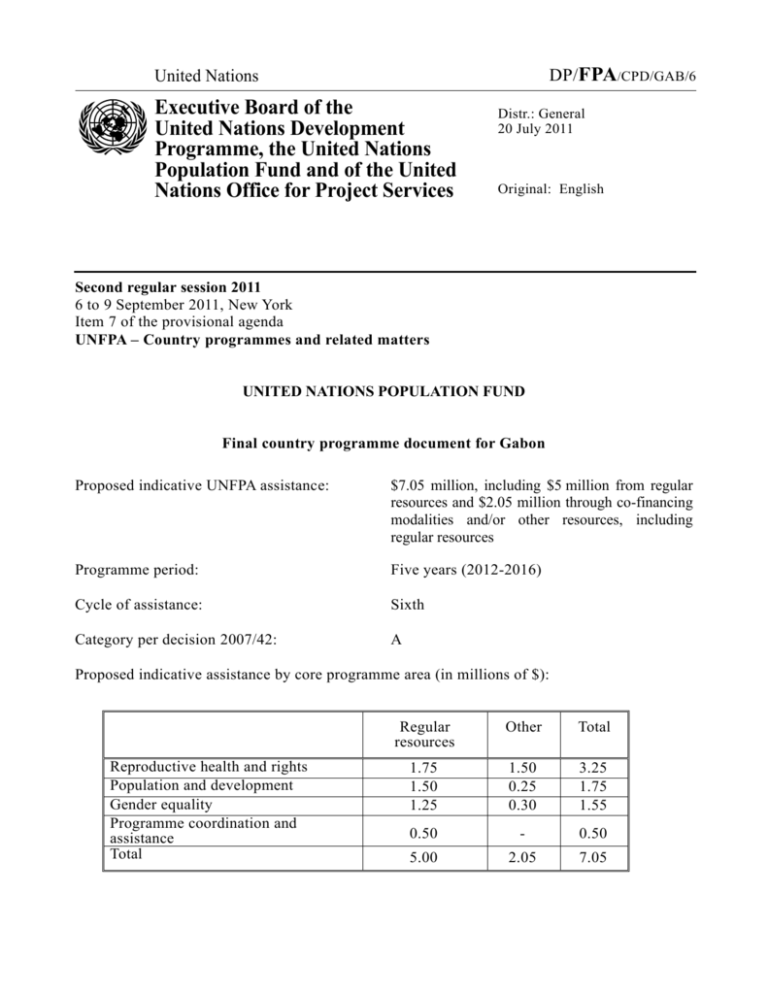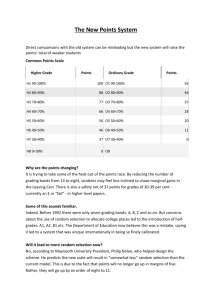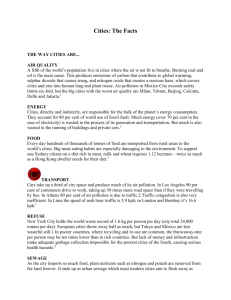National priority: promote human and social development
advertisement

DP/FPA/CPD/GAB/6 United Nations Executive Board of the United Nations Development Programme, the United Nations Population Fund and of the United Nations Office for Project Services Distr.: General 20 July 2011 Original: English Second regular session 2011 6 to 9 September 2011, New York Item 7 of the provisional agenda UNFPA – Country programmes and related matters UNITED NATIONS POPULATION FUND Final country programme document for Gabon Proposed indicative UNFPA assistance: $7.05 million, including $5 million from regular resources and $2.05 million through co-financing modalities and/or other resources, including regular resources Programme period: Five years (2012-2016) Cycle of assistance: Sixth Category per decision 2007/42: A Proposed indicative assistance by core programme area (in millions of $): Reproductive health and rights Population and development Gender equality Programme coordination and assistance Total Regular resources Other Total 1.75 1.50 1.25 1.50 0.25 0.30 3.25 1.75 1.55 0.50 - 0.50 5.00 2.05 7.05 DP/FPA/CPD/GAB/6 I. Situation analysis 1. In 2003, the population of Gabon was approximately 1.5 million. Fifty-two per cent of the population is female, and 60 per cent of the population is under the age of 25. The population is largely urban, with 80 per cent living in the three largest cities. The primary school enrolment rate is 96 per cent, while the literacy rate is 85 per cent. The per capita income was $12,747 in 2010, but there are significant disparities between population groups. Of the 169 countries on the UNDP Human Development Index, Gabon ranked 93. Thirty-three per cent of the population was living below the poverty line in 2005. 2. The fertility rate is 4.74 children per woman. According to the last demographic and health survey (2000), the maternal morality ratio was 519 deaths per 100,000 live births, and the infant mortality rate was 91 deaths per 1,000 live births. However, new United Nations estimates indicate that the maternal mortality ratio has dropped to 260 maternal deaths per 100,000 live births. 3. Access to high-quality, affordable health care remains a major challenge. The prevalence of modern contraceptive methods is low (14 per cent), due to inadequate information on family planning. The unmet need for family planning is estimated at approximately 28 per cent. Early, unprotected sexual intercourse contributes to sexually transmitted diseases, early and unwanted pregnancies, illegal abortions, obstetric fistula (approximately 100 cases were reported in 2010), and one third of all maternal deaths. 4. The HIV/AIDS prevalence rate in the general population was estimated at 5.9 per cent in 2007 and at 5.2 per cent in 2009. The HIV/AIDS prevalence rate increased among 2 youth from 3.6 per cent in 2007 to 4.8 per cent in 2009. Although the HIV/AIDS epidemic is widespread, sex workers, with a prevalence rate of 23.2 per cent in 2009, are the most vulnerable group. The rate of condom use during high-risk sexual behaviour declined from 70.6 per cent in 2007 to 27.4 per cent in 2009. 5. The constitution recognizes gender equality, and the Government has ratified the United Nations Convention on the Elimination of All Forms of Discrimination against Women. Despite significant efforts, gender disparities remain, particularly in political, economic and administrative decision-making spheres. Women hold only 20 per cent of government positions and make up 14 per cent of Parliament. The secondary school enrolment rate is 54 per cent for girls and 60 per cent for boys. Empirical studies show that violence and discrimination against women and young girls is an ongoing problem. 6. The lack of updated and harmonized social indicators, particularly in the health sector, is a major constraint. To strengthen the national statistical system, the Government initiated a national strategy for statistical development. The next general population and housing census is scheduled for 2013. II. Past cooperation and lessons learned 7. The total allocation for the fifth country programme, which covered the period 20072011, was approximately $5.35 million. The programme had three components: (a) reproductive health and rights, including HIV/AIDS prevention; (b) population and development; and (c) gender equality. It forged and expanded strategic partnerships with sectoral ministries and parliamentarians, as well as with media professionals and DP/FPA/CPD/GAB/6 religious groups, to increase social mobilization and foster a sense of national ownership. The programme also supported the development of normative and strategic framework documents, such as the national strategy for gender equality, the national youth policy, the strategic plan for reproductive health commodity security and the national health development plan. 8. The programme reinforced technical and institutional capacity in: (a) reproductive health services, including HIV/AIDS prevention; (b) government and civil society organizations that are concerned with gender, including those that seek to promote the United Nations Convention on the Elimination of All Forms of Discrimination against Women; and (c) statistical services, including by supporting the establishment of a multisectoral database. 9. Major challenges included: (a) limited monitoring and evaluation; (b) inadequate implementation strategies; (c) the lack of baseline data; and (d) weak national coordination capacity. Achievements included the intensification of political advocacy efforts and dialogue on population and development issues. III. Proposed programme 10. The sixth country programme builds on the lessons learned from the evaluation of the fifth country programme, and is aligned with Vision Gabon 2025; Gabon: the Future in Confidence, the President’s development strategy for 2012-2016; the national economic and social development policy paper; sectoral strategic plans, including the 2008-2012 national health development plan and the strategic plan to combat AIDS; the United Nations Development Assistance Framework (UNDAF); the UNFPA strategic plan, 20082013; the Programme of Action of the International Conference on Population and Development; and the Millennium Development Goals. 11. The proposed programme will contribute to national priorities, as derived from the 2012-2016 UNDAF outcomes: (a) a strengthened social statistics data system; (b) multifaceted sensitization on human rights; (c) the enactment by the people of measures designed to improve their well-being; (d) the development of sectoral policies and strategies focusing on equitable and inclusive development; and (e) access to high-quality reproductive health services, including services to prevent HIV/AIDS. 12. The country programme has three components: (a) reproductive health and rights, including HIV/AIDS prevention; (b) population and development; and (c) gender equality. The programme will foster synergy among its components and will apply culturally sensitive and human rightsbased approaches, including those that promote reproductive health and rights. 13. The Government and UNFPA will implement the programme, with support from other United Nations organizations. Civil society stakeholders, including the private sector, will also be involved, along with other development partners. The programme will also benefit from South-South cooperation. Reproductive health and rights component 14. The outcome is: increased access to highquality reproductive health services, commodities and information, including on family planning and HIV prevention, among 3 DP/FPA/CPD/GAB/6 women and adolescents. There are two outputs in this component. 15. Output 1: Increased capacity of health facilities to ensure high-quality reproductive health services, including family planning services, emergency obstetric and neonatal care, the prevention and treatment of obstetric fistula, and measures to ensure reproductive health commodity security. The programme will adopt the following strategies to achieve this output: (a) strengthening institutional, human and technical capacity; (b) improving the collection, analysis and use of health information; and (c) strengthening the planning, procurement, management, monitoring and coordination of reproductive health commodities, including condoms. 16. Output 2: Increased demand for reproductive health services, including those that prevent unwanted pregnancies, sexually transmitted diseases and HIV/AIDS, targeted at youth and high-risk populations. This output will be achieved by: (a) increasing the availability of family planning services and services to prevent HIV/AIDS among adolescents and youth; and (b) developing communication campaigns and strengthening strategic partnerships (with parliamentarians, media, religious groups and civil society) aimed at social mobilization and behavioural change. economic data at national, sectoral and decentralized levels, to implement and monitor development plans and the Millennium Development Goals. This will be achieved by: (a) supporting national advocacy efforts to mobilize financial, technical and human resources for the national population policy, the 2013 general census of population and housing, and other surveys; (b) building technical and human capacity to collect, analyse, manage and disseminate data; (c) building technical and institutional capacity for the national data system in the use and maintenance of the integrated management information system (IMIS); and (d) creating awareness of the importance of statistics to data collectors and political, economic and administrative policymakers. 19. Output 2: Population issues are integrated into policies and programmes. This output will be achieved by: (a) strengthening partnerships with universities as well as training and research institutes to promote population and development issues; (b) supporting the development and implementation of a national youth policy and a national population policy; (c) strengthening the rights of indigenous people to facilitate their integration into the population; and (d) improving access to basic social and economic services for the disabled. Gender equality component Population and development component 17. The outcome of this component is: population, reproductive health and rights and gender equality issues are integrated into poverty eradication policies and programmes. There are two outputs in this component. 18. Output 1: Available and accessible disaggregated demographic and socio4 20. The outcome of this component is: competency in gender analysis in the various economic and social development sectors, and reduced gender-based violence. 21. Output 1: Increased institutional and human capacity to promote women’s rights and gender mainstreaming. The following strategies will help achieve this outcome: DP/FPA/CPD/GAB/6 (a) strengthening the technical and financial capacity of entities responsible for the advancement of women and gender mainstreaming; and (b) enhancing advocacy and communication efforts to mainstream gender concerns in development policies, strategies and programmes. 22. Output 2: Reduced discrimination and gender-based violence, for the effective implementation of women’s rights. The programme will adopt the following strategies: (a) strengthening the legal and regulatory framework to protect women’s rights; (b) enhancing information, education and legal protection for women regarding gender-based violence; and (c) building leadership capacity and promoting the empowerment of women and girls. officer, and several support staff. The country office will recruit national and international project personnel to strengthen the implementation of the programme. UNFPA regional and subregional offices and headquarters units will provide technical and managerial support, in cooperation with national institutions, national consultants and international consultants. IV. Programme management, monitoring and evaluation 23. The Ministry of Economy, Commerce, Industry and Tourism will coordinate the programme, which will be executed by relevant ministries and non-governmental organizations. 24. UNFPA and the Government will manage, monitor and evaluate the programme in accordance with UNFPA rules and procedures, taking into account UNDAF coordination mechanisms. UNFPA and the Government will carry out surveys at the beginning and end of the programme to collect baseline data to monitor and evaluate the programme. 25. The UNFPA country office in Gabon consists of a non-resident country director based in Brazzaville, Republic of the Congo, an international programme officer, an assistant representative, a national programme 5 6 RESULTS AND RESOURCES FRAMEWORK FOR GABON DP/FPA/CPD/GAB/6 National priority: promote human and social development UNDAF outcomes: (a) ownership by communities of preventive measures that are conducive to improving the well-being of communities; and (b) people, particularly the most vulnerable, have access to high-quality services, including on education, health and HIV/AIDS prevention Programme Country programme Country programme outputs, indicators, baselines and targets Partners Indicative component outcomes, indicators, resources by baselines and targets programme component Reproductive Outcome: Increased access to Output 1: Increased capacity of health facilities to ensure high-quality National $3.25 million health high-quality reproductive reproductive health services, including family planning services, emergency Pharmaceutical Office; ($1.75 million obstetric and neonatal care, the prevention and treatment of obstetric fistula, Ministries of: from regular health services , commodities and measures to ensure reproductive health commodity security Culture; Health; resources and and information , including on Output indicators: Social Affairs, National $1.5 million family planning and HIV Solidarity and Family; from other Percentage of obstetric and neonatal complications treated in health facilities that prevention, among women and Youth, Sports and resources) provide comprehensive obstetric and neonatal emergency services adolescents Leisure Baseline: 15 per cent; Target: 25 per cent (2016) Outcome indicators: Number of health facilities offering at least three contraceptive methods Maternal death ratio Gabonese Movement Baseline: 519 maternal deaths per Baseline: not determined; Target: 52 for Family Well-being; Output 2: Increased demand for reproductive health services, including those 100,000 live births (2000) national nonthat prevent unwanted pregnancies, sexually transmitted diseases and Target: 150 maternal deaths per governmental HIV/AIDS, targeted at youth and high-risk populations 100,000 births (2016) organizations; Output indicators: Contraceptive prevalence rate Number of structures offering youth-friendly education and information services in embassies Baseline: 14 per cent (2000) intervention areas Target: 24 per cent (2016) European Union; Baseline: 16 (2010); Target: 25 (2016) Percentage of youth aged 15 to French Development Number of testing centres in the integrated youth information centres 24 who claim to have used Agency; Baseline: 1 (2011); Target: 9 (2016) condoms during their last sexual Joint United Nations encounter Programme on Baseline: 27.4 per cent (2009) HIV/AIDS; Target: 60 per cent (2016) United Nations Children’s Fund; UNDP; United Nations Educational, Scientific and Cultural Organization; United Nations High Commissioner for Refugees; World Bank; World Health Organization UNDAF outcome: a national data mechanism producing high-quality information to monitor Millennium Development Goals and the social sectors Population and development Outcome: Population, reproductive health and rights and gender equality issues are integrated into poverty eradication policies and programmes Outcome indicator: Number of policies and programmes produced incorporating dimensions related to population and development, reproductive health and gender equality Baseline: 5 (2010); Target: 10 Output 1: Available and accessible disaggregated demographic and socioMinistries of: Culture; $1.75 million economic data at national, sectoral and decentralized levels, to implement and Economy, Commerce, ($1.5 million monitor development plans and the Millennium Development Goals Industry and Tourism; from regular Outcome indicators: Health; resources and Higher Education; $0.25 million Percentage of decentralized facilities at district and provincial levels that collect National Education; from other and manage health information, using reliable and current data Scientific Research and resources) Baseline: 0 per cent; Target: 50 per cent Technological Number of sectoral social statistics documents produced Development; Baseline: to be determined; Target: 5 Social Affairs, National Output 2: Population issues are integrated into policies and programmes Solidarity and Family; Output indicators: Youth, Sports and Number of policies adopted that specifically address population issues Leisure; and other Baseline: 0 (2010); Target: 4 sectoral ministries Number of memorandums of understanding signed with universities and/or training or research institutes that promote population and development issues Baseline: 0; Target: 5 UNDAF outcome: people, particularly the most vulnerable, benefit from sector-based policies and strategies focusing on the equitable and inclusive development of human capital Gender equality Outcome: Competency in gender analysis in the various economic and social development sectors, and reduced gender-based violence Outcome indicators: Number of cases of sexual violence reported Number of policies and programmes addressing gender equality Output 1: Increased institutional and human resource capacity to promote women’s rights and gender mainstreaming Outcome indicator: Number of staff in institutional and non-governmental entities that have received gender training Baseline: 50 (2010); Target: 100 per year Output 2: Reduced discrimination and gender-based violence, for the effective implementation of women’s rights Outcome indicators: Percentage of victims of gender-based violence who are referred to, and provided with, care Baseline: to be determined; Target: 50 per cent Number of texts containing discriminatory provisions that are revised and circulated Baseline: to be determined; Target: 5 Civil society organizations, including media outlets $1.55 million ($1.25 million from regular resources and $0.3 million from other resources) Total for programme coordination and assistance: $0.5 million DP/FPA/CPD/GAB/6 __________________ Attorney-General; Ministries of: Health; Social Affairs, National Solidarity and Family; Justice; National Assembly; Network of female senators; Network of female parliamentarians; Prime Minister’s Office; Senate 7






